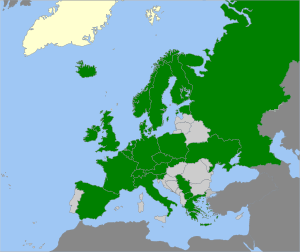Lemon-yellow brushwood cup
| Lemon-yellow brushwood cup | ||||||||||||
|---|---|---|---|---|---|---|---|---|---|---|---|---|

Lemon yellow brushwood cup ( Bisporella citrina ) |
||||||||||||
| Systematics | ||||||||||||
|
||||||||||||
| Scientific name | ||||||||||||
| Bisporella citrina | ||||||||||||
| ( Batsch : Fr. ) Korf & SECarp. |
The small, inedible lemon-yellow wooden cup or lemon-yellow brushwood cup ( Bisporella citrina , syn. Calycella citrina ) is a species of fungus from the Helotiaceae family. The small, plate-shaped and bright yellow fruiting bodies often grow in a grassy manner on debarked red beech wood.
features
Macroscopic features
The thick-fleshed and more or less sessile fruit bodies ( apothecia ) are initially flat, bowl-shaped and 1–3 mm wide. Because of their convex fruit slice, they are reminiscent of a small protruding nail head. The crowded, standing fruit bodies are usually bent into a bump and tend to grow together. The color is bright lemon or sulfur yellow in all parts. The blunt edge is bare, the smooth outside is usually a bit paler and the spore powder is white.
Microscopic features
The elongated-elliptical and slightly curved spores measure 8–13 µm × 3–4 µm. They are smooth, hyaline and, when ripe, are often constricted and septate. They usually contain tiny oil droplets on each end of the spore. The cylindrical, lobed tubes ( asci ) measure 80–140 × 5–6 µm. The filamentous paraphyses have yellow granulation and are slightly thickened at the tip.
Species delimitation
The lemon yellow wooden cup has a large number of similar relatives, which differ in their slightly different colors or locations. A reliable differentiation is usually only possible with a microscope. Because of its often grassy growth on debarked beech branches, the lemon-yellow wooden cup is relatively easy to see even without a microscope. The calyx-shaped stem cup ( Hymenoscyphus calycollus ), which also occurs on hardwood, is particularly similar , but has clearly stalked and larger fruiting bodies. Its spores are up to 20 µm long.
The sulfur- yellow core mushroom cup ( Bisporella sulfurina ) is even more similar . It grows on rotten hardwood branches such as maple, ash or linden that are colonized by heart mushrooms .
Ecology and diffusion
The lemon yellow wooden cup is often found in large flocks on damp, dead branches of deciduous trees lying on the ground. It mainly grows on red beech wood. The fruiting bodies usually only appear in autumn.
The fungus is found almost worldwide. It has been found in North America (Canada, Mexico, USA), Central America (Costa Rica), South America (Chile), Asia (China, India, Japan, South Korea, Turkey), North Africa (Algeria, Morocco), Australia, New Zealand and Europe. The wooden cup is widespread in Europe and probably quite common everywhere.
meaning
Since the fruit bodies are only a few millimeters in size, the lemon yellow wooden cup is not an edible mushroom.
swell
- Paul Kirk: Bisporella citrina. In: Species Fungorum. Retrieved January 4, 2014 .
- Bisporella citrina. In: MycoBank.org. International Mycological Association, accessed January 4, 2014 .
Individual evidence
- ↑ a b c d e Ewald Gerhardt: Röhrlinge, Porlinge, Bauchpilze, hose mushrooms and others . In: mushrooms. Spectrum of nature, BLV intensive guide . tape 2 . BLV, Munich / Vienna / Zurich 1985, ISBN 3-405-12965-6 , p. 252 .
- ↑ a b Karin Monday: Lemon-yellow brushwood cup Bisporella citrina In the virtual mushroom book. In: Tintling.com. Retrieved January 4, 2014 .
- ↑ Marcel Bon : Parey's book of mushrooms . Kosmos, Stuttgart 2005, ISBN 3-440-09970-9 , pp. 332 (English: The mushrooms and tools of Britain and Northwestern Europe . Translated by Till R. Lohmeyer).
- ↑ a b Worldwide distribution of Bisporella citrina. (No longer available online.) In: GBIF Portal / data.gbif.org. Archived from the original on January 8, 2014 ; accessed on January 6, 2014 .
- ^ DM Dimou, GI Zervakis, E. Polemis: Mycodiversity studies in selected ecosystems of Greece: I. Macrofungi from the southernmost Fagus forest in the Balkans (Oxya Mountain, central Greece) . In: Mycotaxon . tape 82 , 2002, pp. 177-205 (English, cybertruffle.org.uk ).
- ^ S. Petkovski: National Catalog (Check List) of Species of the Republic of Macedonia . In: Acta Botanica Croatica . 2009 (English, protectedareas.mk ( Memento from February 15, 2010 in the Internet Archive ) [PDF; 1.6 MB ]). National Catalog (Check List) of Species of the Republic of Macedonia ( Memento of the original from February 15, 2010 in the Internet Archive ) Info: The archive link has been inserted automatically and has not yet been checked. Please check the original and archive link according to the instructions and then remove this notice.
- ↑ Bisporella citrina. Pilzoek database, accessed January 6, 2014 .
- ^ TV Andrianova and others: Bisporella citrina. In: Fungi of Ukraine. Retrieved January 6, 2014 .
- ↑ NMV Verspreidingsatlas online. Bisporella citrina. In: verspreidingsatlas.nl. Retrieved January 6, 2014 .
Web links
- Bisporella citrina. In: Funghi in Italia / funghiitaliani.it. Retrieved January 4, 2014 (Italian, photos from the lemon yellow wooden cup).
- M. Kuo: Bisporella citrina. In: MushroomExpert.Com. Retrieved January 4, 2014 .
